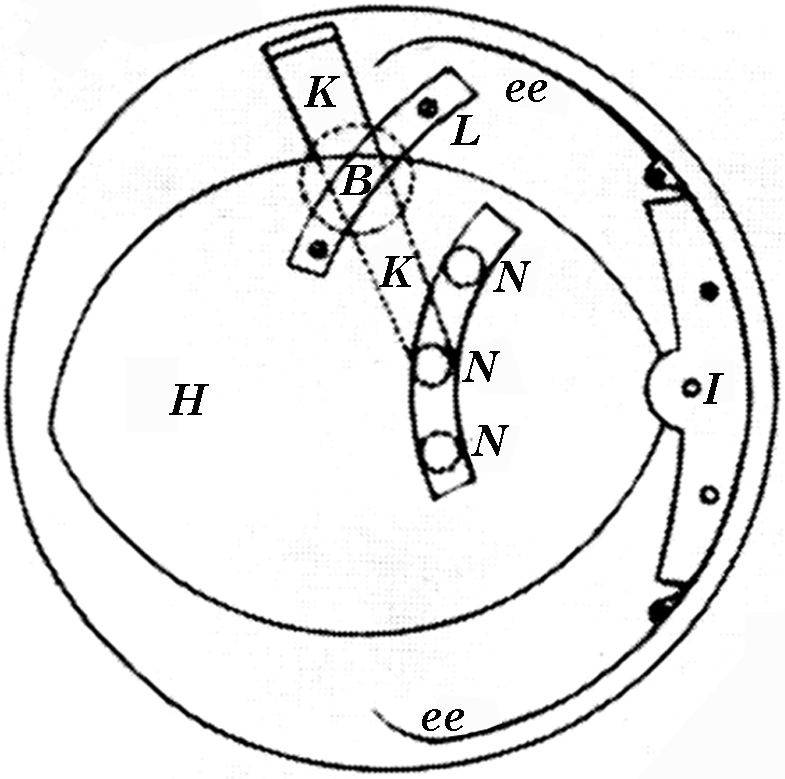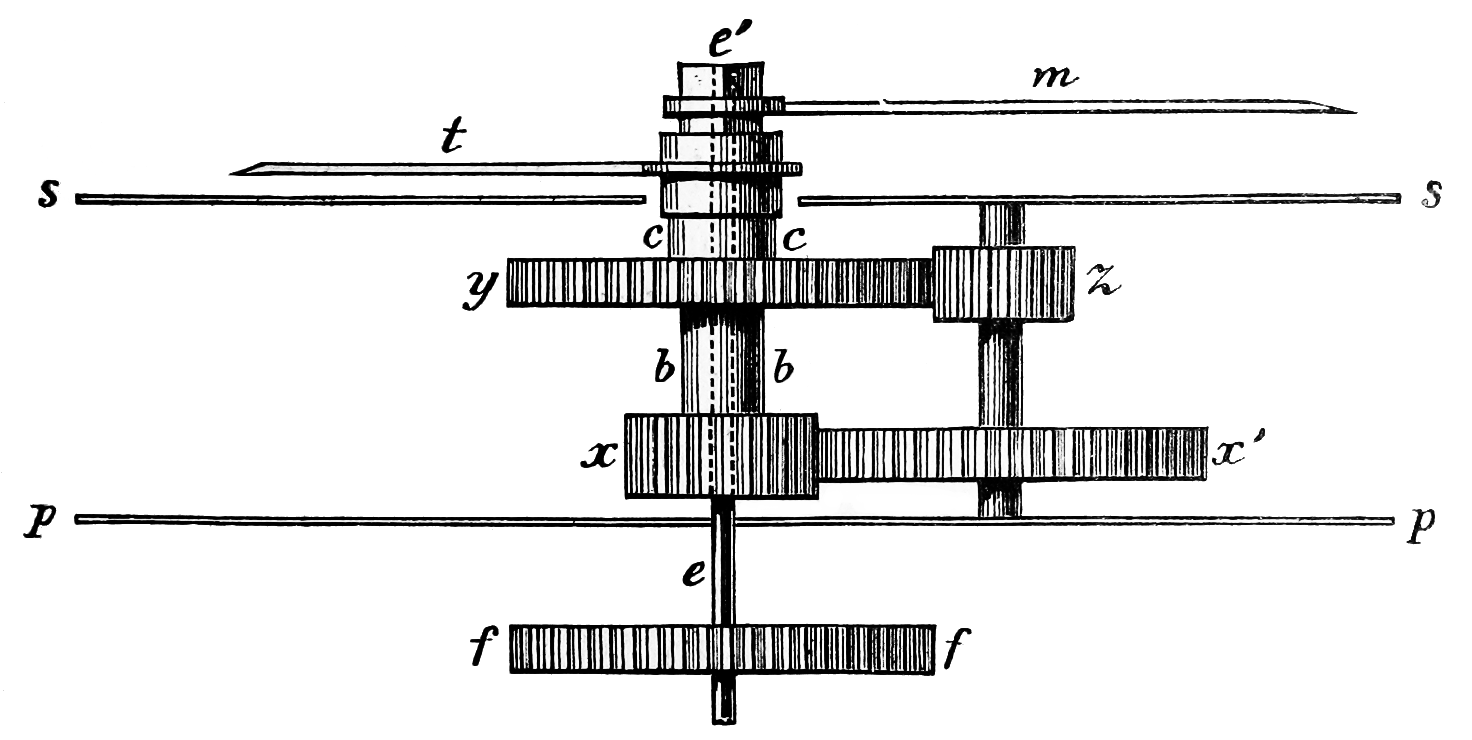|
Hand-wound
A mechanical watch is a watch that uses a clockwork mechanism to measure the passage of time, as opposed to quartz watches which function using the vibration modes of a piezoelectric quartz tuning fork, or radio watches, which are quartz watches synchronized to an atomic clock via radio waves. A mechanical watch is driven by a mainspring which must be wound either periodically by hand or via a self-winding mechanism. Its force is transmitted through a series of gears to power the balance wheel, a weighted wheel which oscillates back and forth at a constant rate. A device called an escapement releases the watch's wheels to move forward a small amount with each swing of the balance wheel, moving the watch's hands forward at a constant rate. The escapement is what makes the 'ticking' sound which is heard in an operating mechanical watch. Mechanical watches evolved in Europe in the 17th century from spring powered clocks, which appeared in the 15th century. Mechanical w ... [...More Info...] [...Related Items...] OR: [Wikipedia] [Google] [Baidu] |
Automatic Watch
An automatic watch, also known as a self-winding watch or simply an automatic, is a mechanical watch where the natural motion of the wearer provides energy to wind the mainspring, making manual winding unnecessary if worn enough. It is distinguished from a ''manual watch'' in that a manual watch must have its mainspring wound by hand at regular intervals. Operation In a mechanical watch the watch's gears are turned by a spiral spring called a mainspring. In a ''manual watch'' energy is stored in the mainspring by turning a knob, the ''crown'' on the side of the watch. Then the energy from the mainspring powers the watch movement until it runs down, requiring the spring to be wound again. A self-winding watch movement has a mechanism which winds the mainspring using the natural motions of the wearer's body. The watch contains an oscillating weight that turns on a pivot. The normal movements of the watch in the user's pocket (for a pocketwatch) or on the user's arm (for a wristwat ... [...More Info...] [...Related Items...] OR: [Wikipedia] [Google] [Baidu] |
Mainspring
A mainspring is a spiral torsion spring of metal ribbon—commonly spring steel—used as a power source in mechanical watches, some clocks, and other clockwork mechanisms. ''Winding'' the timepiece, by turning a knob or key, stores energy in the mainspring by twisting the spiral tighter. The force of the mainspring then turns the clock's wheels as it unwinds, until the next winding is needed. The adjectives wind-up and spring-powered refer to mechanisms powered by mainsprings, which also include kitchen timers, metronomes, music boxes, wind-up toys and clockwork radios. Modern mainsprings A modern watch mainspring is a long strip of hardened and blued steel, or specialised steel alloy, 20–30 cm long and 0.05-0.2 mm thick. The mainspring in the common 1-day movement is calculated to enable the watch to run for 36 to 40 hours, i.e. 24 hours between daily windings with a power-reserve of 12 to 16 hours, in case the owner is late winding the watch. This is the nor ... [...More Info...] [...Related Items...] OR: [Wikipedia] [Google] [Baidu] |
Russian Finished Watch Movement
Russian(s) refers to anything related to Russia, including: *Russians (, ''russkiye''), an ethnic group of the East Slavic peoples, primarily living in Russia and neighboring countries *Rossiyane (), Russian language term for all citizens and people of Russia, regardless of ethnicity *Russophone, Russian-speaking person (, ''russkogovoryashchy'', ''russkoyazychny'') * Russian language, the most widely spoken of the Slavic languages * Russian alphabet * Russian cuisine *Russian culture *Russian studies Russian may also refer to: *Russian dressing *''The Russians'', a book by Hedrick Smith *Russian (comics), fictional Marvel Comics supervillain from ''The Punisher'' series *Russian (solitaire), a card game * "Russians" (song), from the album ''The Dream of the Blue Turtles'' by Sting *"Russian", from the album ''Tubular Bells 2003'' by Mike Oldfield *"Russian", from the album '' '' by Caravan Palace * Nik Russian, the perpetrator of a con committed in 2002 *The South African name f ... [...More Info...] [...Related Items...] OR: [Wikipedia] [Google] [Baidu] |
Status Symbol
A status symbol is a visible, external symbol of one's social position, an indicator of economic or social status. Many luxury goods are often considered status symbols. ''Status symbol'' is also a sociological term – as part of social and sociological symbolic interactionism – relating to how individuals and groups interact and interpret various cultural symbols. By region and time As people aspire to high status, they often seek also its symbols. As with other symbols, status symbols may change in value or meaning over time, and will differ among countries and cultural regions, based on their economy and technology. For example, before the invention of the printing press, possession of a large collection of laboriously hand-copied books was a symbol of wealth and scholarship. In later centuries, books (and literacy) became more common, so a private library A private library is a library that is privately owned. Private libraries are usually intended for the use ... [...More Info...] [...Related Items...] OR: [Wikipedia] [Google] [Baidu] |
Frequency
Frequency is the number of occurrences of a repeating event per unit of time. It is also occasionally referred to as ''temporal frequency'' for clarity, and is distinct from ''angular frequency''. Frequency is measured in hertz (Hz) which is equal to one event per second. The period is the interval of time between events, so the period is the reciprocal of the frequency. For example, if a heart beats at a frequency of 120 times a minute (2 hertz), the period, —the interval at which the beats repeat—is half a second (60 seconds divided by 120 beats). Frequency is an important parameter used in science and engineering to specify the rate of oscillatory and vibratory phenomena, such as mechanical vibrations, audio signals (sound), radio waves, and light. Definitions and units For cyclical phenomena such as oscillations, waves, or for examples of simple harmonic motion, the term ''frequency'' is defined as the number of cycles or vibrations per unit of time. Th ... [...More Info...] [...Related Items...] OR: [Wikipedia] [Google] [Baidu] |
Harmonic Oscillator
In classical mechanics, a harmonic oscillator is a system that, when displaced from its Mechanical equilibrium, equilibrium position, experiences a restoring force ''F'' Proportionality (mathematics), proportional to the displacement ''x'': \vec F = -k \vec x, where ''k'' is a positive coefficient, constant. If ''F'' is the only force acting on the system, the system is called a simple harmonic oscillator, and it undergoes simple harmonic motion: sinusoidal oscillations about the equilibrium point, with a constant amplitude and a constant frequency (which does not depend on the amplitude). If a frictional force (Damping ratio, damping) proportional to the velocity is also present, the harmonic oscillator is described as a damped oscillator. Depending on the friction coefficient, the system can: * Oscillate with a frequency lower than in the Damping ratio, undamped case, and an amplitude decreasing with time (Damping ratio, underdamped oscillator). * Decay to the equilibrium p ... [...More Info...] [...Related Items...] OR: [Wikipedia] [Google] [Baidu] |
Oscillation
Oscillation is the repetitive or periodic variation, typically in time, of some measure about a central value (often a point of equilibrium) or between two or more different states. Familiar examples of oscillation include a swinging pendulum and alternating current. Oscillations can be used in physics to approximate complex interactions, such as those between atoms. Oscillations occur not only in mechanical systems but also in dynamic systems in virtually every area of science: for example the beating of the human heart (for circulation), business cycles in economics, predator–prey population cycles in ecology, geothermal geysers in geology, vibration of strings in guitar and other string instruments, periodic firing of nerve cells in the brain, and the periodic swelling of Cepheid variable stars in astronomy. The term ''vibration'' is precisely used to describe a mechanical oscillation. Oscillation, especially rapid oscillation, may be an undesirable phenomenon in proc ... [...More Info...] [...Related Items...] OR: [Wikipedia] [Google] [Baidu] |
Keyless Work
In horology, a wheel train (or just train) is the gear train of a mechanical watch or clock. Although the term is used for other types of gear trains, the long history of mechanical timepieces has created a traditional terminology for their gear trains which is not used in other applications of gears. Watch movements are very standardized, and the wheel trains of most watches have the same parts. The wheel trains of clocks are a little more varied, with different numbers of wheels depending on the type of clock and how many hours the clock runs between windings (the "going"). However, the wheel trains of clocks and watches share the same terminology, and are similar enough that they can be described together. The large gears in timepieces are generally called ''wheels'', the smaller gears they mesh with (large to small, large to small) are called pinions, and the shafts that the wheels and pinions are mounted on are called ''arbors''. The wheels are mounted between the plates of ... [...More Info...] [...Related Items...] OR: [Wikipedia] [Google] [Baidu] |
Hour
An hour (symbol: h; also abbreviated hr) is a unit of time conventionally reckoned as of a day and scientifically reckoned between 3,599 and 3,601 seconds, depending on the speed of Earth's rotation. There are 60 minutes in an hour, and 24 hours in a day. The hour was initially established in the ancient Near East as a variable measure of of the night or daytime. Such seasonal, temporal, or unequal hours varied by season and latitude. Equal or equinoctial hours were taken as of the day as measured from noon to noon; the minor seasonal variations of this unit were eventually smoothed by making it of the mean solar day. Since this unit was not constant due to long term variations in the Earth's rotation, the hour was finally separated from the Earth's rotation and defined in terms of the atomic or physical second. In the modern metric system, hours are an accepted unit of time defined as 3,600 atomic seconds. However, on rare occasions an hour may incorporate a positive ... [...More Info...] [...Related Items...] OR: [Wikipedia] [Google] [Baidu] |
Minute
The minute is a unit of time usually equal to (the first sexagesimal fraction) of an hour, or 60 seconds. In the UTC time standard, a minute on rare occasions has 61 seconds, a consequence of leap seconds (there is a provision to insert a negative leap second, which would result in a 59-second minute, but this has never happened in more than 40 years under this system). Although not an SI unit, the minute is accepted for use with SI units. The SI symbol for ''minute'' or ''minutes'' is min (without a dot). The prime symbol is also sometimes used informally to denote minutes of time. History Al-Biruni first subdivided the hour sexagesimally into minutes, seconds, thirds and fourths in 1000 CE while discussing Jewish months. Historically, the word "minute" comes from the Latin ''pars minuta prima'', meaning "first small part". This division of the hour can be further refined with a "second small part" (Latin: ''pars minuta secunda''), and this is where the word "second" comes ... [...More Info...] [...Related Items...] OR: [Wikipedia] [Google] [Baidu] |
Second
The second (symbol: s) is the unit of time in the International System of Units (SI), historically defined as of a day – this factor derived from the division of the day first into 24 hours, then to 60 minutes and finally to 60 seconds each (24 × 60 × 60 = 86400). The current and formal definition in the International System of Units ( SI) is more precise:The second ..is defined by taking the fixed numerical value of the caesium frequency, Δ''ν''Cs, the unperturbed ground-state hyperfine transition frequency of the caesium 133 atom, to be when expressed in the unit Hz, which is equal to s−1. This current definition was adopted in 1967 when it became feasible to define the second based on fundamental properties of nature with caesium clocks. Because the speed of Earth's rotation varies and is slowing ever so slightly, a leap second is added at irregular intervals to civil time to keep clocks in sync with Earth's rotation. Uses Analog clocks and watches often ... [...More Info...] [...Related Items...] OR: [Wikipedia] [Google] [Baidu] |
Wheel Train
In horology, a wheel train (or just train) is the gear train of a mechanical watch or Mechanical clock, clock. Although the term is used for other types of gear trains, the long history of mechanical timepieces has created a traditional terminology for their gear trains which is not used in other applications of gears. Watch movement (clockwork), movements are very standardized, and the wheel trains of most watches have the same parts. The wheel trains of clocks are a little more varied, with different numbers of wheels depending on the type of clock and how many hours the clock runs between windings (the "going"). However, the wheel trains of clocks and watches share the same terminology, and are similar enough that they can be described together. The large gears in timepieces are generally called ''wheels'', the smaller gears they mesh with (large to small, large to small) are called pinions, and the shafts that the wheels and pinions are mounted on are called ''arbors''. The ... [...More Info...] [...Related Items...] OR: [Wikipedia] [Google] [Baidu] |








.jpg)